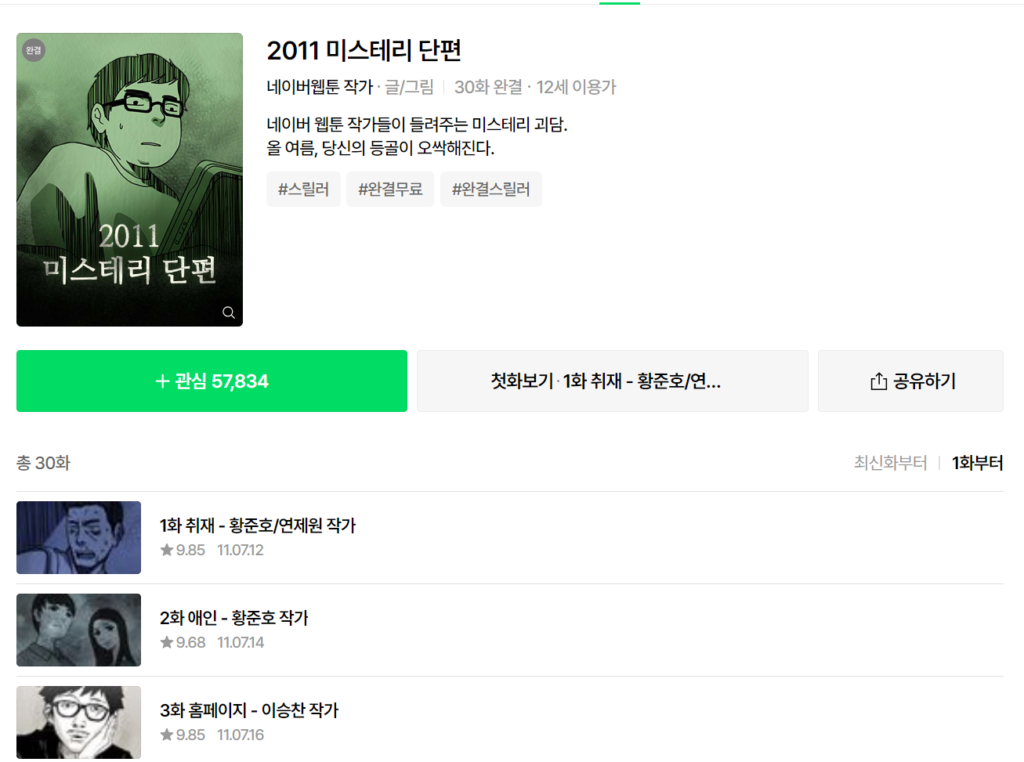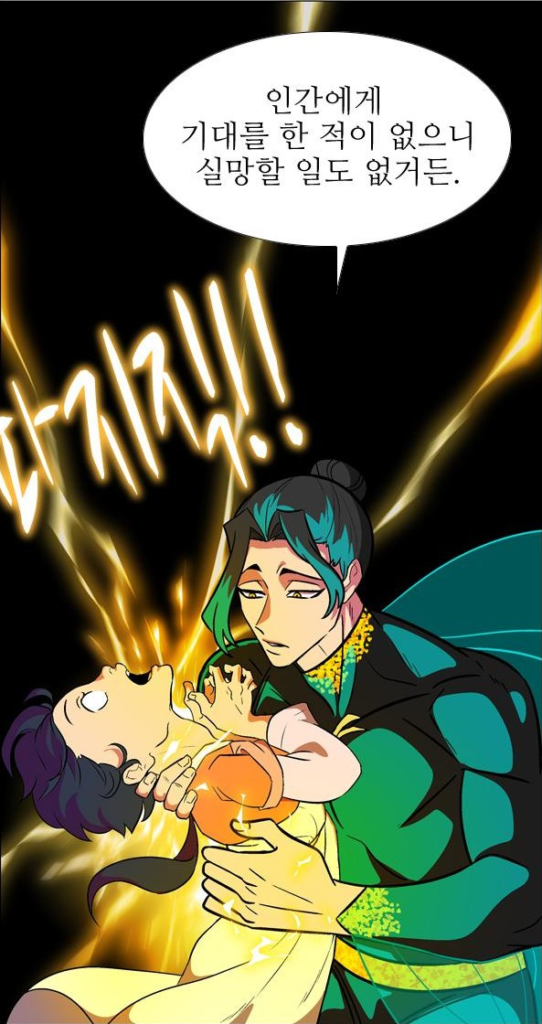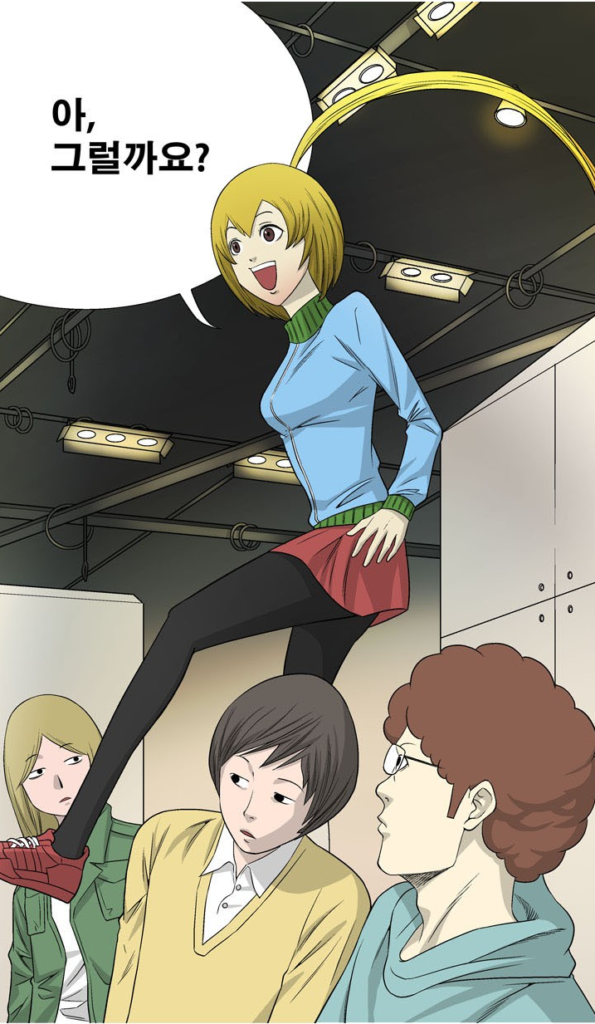There were actually complaints from people living in that area. “It’s too scary.” (Translated by the author)
‐ホラン, July 9, 2014
[blogcard url=”https://www.mk.co.kr/news/all/6176661″]
In 2011, an incident shook the Korean Webtoon scene. A work that was released at the time became a topic of discussion for being “too scary.” What was the content that caused such a stir?
Back then, I had no tolerance for horror at all, so I started reading the works that were popular years later.
One example is the work I briefly mentioned in the previous post, “戦おう幽霊よ” (2007). Despite being in the horror genre, it gained popularity due to its unique humor and interesting storyline. If it hadn’t shifted to a gag manga style midway, I might never have read it.



[blogcard url=”https://comic.naver.com/webtoon/list?titleId=23182&tab=finish”]
Therefore, of course, there was no way I could read the “too scary” Webtoon that was popular at the time. However, hearing that it was covered by the media and gained attention overseas, I made a big decision. After school, I gathered about five friends in the classroom to read the Webtoon.
What was the work that I went to such ridiculous lengths to read? It was the two episodes “オクス駅の幽霊” and “ボンチョドンの幽霊” that were featured in the “2011年度ホラー短編集.”
By the way, unlike the previous work “強いやつ,” this one was published four years ago under the name “2020怪談短編集” on LINE Manga. As a result, the titles have also changed to “プラットフォーム幽霊” and “裏参道の幽霊.”
The 9th and 10th episodes of this short story collection are the ones that became a topic of discussion. Viewer discretion is advised for those who are not good with horror.🚫
[blogcard url=”https://manga.line.me/pr/horror_2020_summer/”]

the front page of LINE Manga “2020怪談短編集” (2020).

is NAVER WEBTOON’s “2011ミステリー短編” (2011).
Looking back now, many might not find it that scary.
I also laughed when I reread this work after 13 years, wondering, “Why was I so scared back then?” But the reason is clear. It was simply because there were “no such outrageous works” in Webtoons 13 years ago.
The Webtoon creator who wrote this work, ホラン, showcased unprecedented directing techniques that were unimaginable at the time. One of the notable attempts in this work was the use of “3D software and FLASH for animation effects.” The horror Webtoons that were typically static suddenly moving in front of readers must have been unimaginable back then.
In the aforementioned episodes, “オクス駅の幽霊” (Japanese name: プラットフォーム幽霊) uses 3D software to create an effect where hands seem to pop out of the screen. However, what deserves more attention is “ボンチョドンの幽霊” (Japanese name: 裏参道の幽霊). While it is now remastered to have a similar 3D effect as “オクス駅の幽霊,”
when this episode was released 13 years ago, it was the first Webtoon to attempt a technique that forced users to scroll down using FLASH, making several images appear to move, akin to the first attempt at a flipbook-style animation in Webtoons.
From a technical standpoint, I believe that current Webtoons are still at the level of simply bringing published comics to the web. I want to establish the standards for production techniques of “interactive toons” that can express what digital media can offer and respond to user interactions. (Translated by the author)
-ホラン, May 23, 2014
[blogcard url=”https://news.mt.co.kr/mtview.php?no=2014052311263945369″]
Continuing from the previous discussion, one of the criteria that define current Webtoons is “reading methods suitable for smartphones and tablets.”
However, we often overlook the fundamental premise that “we are reading comics on digital media, not on paper.”
Paper allows for self-regulated reading pace.
Images on paper do not move unless flipped.
Printed comics do not make sounds.
The common sense of (paper) comics that we took for granted is overturned when it comes to digital. ホラン was the only Webtoon creator who began to question what people at the time ignored or overlooked.
Triggered by these two works that shocked not only Webtoon readers but also those who had no prior interest, the Webtoon scene underwent significant changes.
The most notable change was that Webtoons began to include BGM. While it is now common to have a feature to add BGM from Webtoon sites, until the early 2010s, it was nearly impossible to include BGM without ホラン’s assistance, leading to his name being credited in many works.
Even in the late 2010s, when the reading methods for Webtoons were in disarray, ホラン’s name continued to be widely recognized. From the smart-toon where panels are swiped horizontally to fit smartphone screens, to the moving-toon where images move in accordance with scrolling, and the cut-toon where square panels flow horizontally, ホラン was referred to as a Prometheus who brought change to Webtoons.
The reading methods of Webtoons have undergone various attempts to reach their current form.


The genre that exists on the boundary between comics and animation is referred to as “motion comics” abroad. In Korea, it is said that the beginning of this genre was ホラン’s Webtoon “オクス駅の幽霊” released in 2011. (Translated by the author)
[blogcard url=”https://www.hani.co.kr/arti/culture/culture_general/645612.html”]
ホラン did not simply create a work where “the images come to life.” What he created was the awareness that readers had almost forgotten: “we are reading comics digitally, not on paper.”
Even now, Webtoon works that have moving images are still considered quite rare. However, to reach the current form of Webtoons that are easy to read on smartphones and tablets, this awareness is essential.
This time, I haven’t delved deeply into the content of the works due to the nature of this post. However, among the readers of this text, there may be those who want to experience the history of Webtoons and touch upon their changes. For those fashionable individuals, I would like to recommend this work…
[blogcard url=”https://manga.line.me/pr/horror_2020_summer/”]
Park Juhyun
Born in 1998, from Korea. Working at a Japanese animation studio since this year. Has been reading Webtoons for over 15 years and realized that he has spent over 100,000 yen on advance reading fees. Currently writing articles on Webtoons with the desire to earn back what he has spent through view counts.
